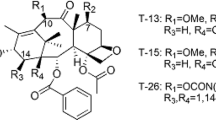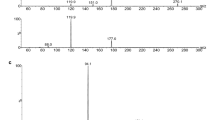Abstract
Purpose
N-[2-(dimethylamino)ethyl]-2,6-dimethyl-1-oxo-1,2-dihydrobenzo[b]-1,6-naphthyridine-4-carboxamide (SN 28049), a DNA-binding benzonaphthyridine, has shown curative activity against colon-38 adenocarcinoma after a single dose in mice. A homologous series of 5 compounds, where the 2-methyl group was replaced by a hydrogen, ethyl, propyl, or butyl, was used to evaluate the role of lipophilicity and tumour pharmacokinetics on their antitumour activity.
Methods
All analogues were administered (25 μmol/kg) to healthy and tumour-bearing C57 Bl/6 mice and concentrations were measured in plasma, brain, heart, kidney, liver, lung, and tumour tissues. Microsomal stability studies were performed with mouse livers and plasma protein binding studies by equilibrium dialysis.
Results
Plasma pharmacokinetics conformed to a model where increasing lipophilicity was associated with a decreasing area under the concentration–time curve (AUC), an increasing clearance and volume of distribution. In contrast, tumour pharmacokinetic parameters showed a very different relationship, where the AUC of the methyl derivative (2,334 μM h) was 89-fold higher than that of the hydrogen derivative (26.3 μM h), with other homologues having intermediate values. The tumour AUC correlated (r = −0.98, P = 2 × 10−7) with the in vivo antitumour activity of this series. The methyl derivative had a 22 min microsomal half-life, while other analogues ranged from 1.6 to 12.2 min. The plasma-free fraction decreased (17–5 %) significantly with lipophilicity (r = 0.96, P = 2 × 10−7).
Conclusion
The plasma pharmacokinetics of this series is related to changes in drug lipophilicity. However, the tumour pharmacokinetics reveals a strong dependence on the nitrogen substituent on the benzonaphthyridine chromophore, with the methyl group providing by far the best tumour tissue retention.






Similar content being viewed by others
References
Bridewell D, Porter A, Finlay G, Baguley B (2008) The role of topoisomerases and RNA transcription in the action of the antitumour benzonaphthyridine derivative SN 28049. Cancer Chemother Pharmacol 62:753–762
Deady LW, Rodemann T, Zhuang L, Baguley BC, Denny WA (2003) Synthesis and cytotoxic activity of carboxamide derivatives of benzo[b] [1,6]naphthyridines. J Med Chem 46:1049–1054
Lukka PB, Paxton JW, Kestell P, Baguley BC (2010) Pharmacokinetics and distribution of SN 28049, a novel DNA binding anticancer agent, in mice. Cancer Chemother Pharmacol 65:1145–1152
Deady LW, Rogers ML, Zhuang L, Baguley BC, Denny WA (2005) Synthesis and cytotoxic activity of carboxamide derivatives of benzo[b][1,6]naphthyridin-(5H)ones. Bioorganic Med Chem 13:1341–1355
Jagow R, Kampffmeyer H, Kinese M (1965) The preparation of microsomes. Naunyn-Schmiedeberg’s Arch Pharmacol 251:73–87
Smith PK, Krohn RI, Hermanson GT, Mallia AK, Gartner FH, Provenzano MD, Fujimoto EK, Goeke NM, Olson BJ, Klenk DC (1985) Measurement of protein using bicinchoninic acid. Anal Biochem 150:76–85
Banker MJ, Clark TH, Williams JA (2003) Development and validation of a 96-well equilibrium dialysis apparatus for measuring plasma protein binding. J Pharm Sci 92:967–974
Boudinot FD, Jusko WJ (1984) Fluid shifts and other factors affecting plasma protein binding of prednisolone by equilibrium dialysis. J Pharm Sci 73:774–780
Lukka PB, Paxton JW, Atwell GJ, Kestell P, Baguley BC (2012) A rapid LC–MS/MS method for the quantitation of a series of benzonaphthyridine derivatives: application to in vivo pharmacokinetic and lipophilicity studies in drug development. J Pharm Biomed Anal 63:9–16
Siim BG, Hicks KO, Pullen SM, van Zijl PL, Denny WA, Wilson WR (2000) Comparison of aromatic and tertiary amine N-oxides of acridine DNA intercalators as bioreductive drugs: cytotoxicity, DNA binding, cellular uptake, and metabolism. Biochem Pharmacol 60:969–978
Paxton JW, Young D, Evans SMH, Robertson IGC, Kestell P (1993) Tumour profile of N -[2-(dimethylamino)ethyl]acridine-4-carboxamide after intraperitoneal administration in the mouse. Cancer Chemother Pharmacol 32:320–322
Formelli F, Carsana R, Pollini C (1986) Comparative pharmacokinetics and metabolism of doxorubicin and 4-demethoxy-4′-O-methyldoxorubicin in tumor-bearing mice. Cancer Chemother Pharmacol 16:15–21
Cain BF, Atwell GJ, Denny WA (1975) Potential antitumour agents. 16. 4′-(acridin-9-ylamino)methanesulfonanilides. J Med Chem 18:1110–1117
HvD Waterbeemd, Smith DA, Beaumont K, Walker DK (2001) Property-based design: optimization of drug absorption and pharmacokinetics. J Med Chem 44:1313–1333
Varma MV, Feng B, Obach RS, Troutman MD, Chupka J, Miller HR, El-Kattan A (2009) Physicochemical determinants of human renal clearance. J Med Chem 52:4844–4852
Johnson TW, Dress KR, Edwards M (2009) Using the golden triangle to optimize clearance and oral absorption. Bioorg Med Chem Lett 19:5560–5564
Richet C (1893) On the relationship between the toxicity and the physical properties of substances. Compt Rendus Seances Soc Biol 9:775–776
Mannhold R (2005) The impact of lipophilicity in drug research: a case report on β-blockers. Mini Rev Med Chem 5:197–205
Smith DA, Jones BC, Walker DK (1996) Design of drugs involving the concepts and theories of drug metabolism and pharmacokinetics. Med Res Rev 16:243–266
Waring MJ (2010) Lipophilicity in drug discovery. Expert Opin Drug Discov 5:235–248
Arcamone F, Casazza AM, Cassinelli G, Di Marco A, Penco S (1982) Doxorubicin and related compounds. II. Structure-activity considerations. M. Nijhoff Publishers, The Hague
Facchetti I, Grandi M, Cucchi P, Geroni C, Penco S, Vigevani A (1991) Influence of lipophilicity on cytotoxicity of anthracyclines in LoVo and LoVo/Dx human cell lines. Anti-Cancer Drug Des 6:385–397
Hofsli E, Nissen-Meyer J (1990) Reversal of multidrug resistance by lipophilic drugs. Cancer Res 50:3997
Genka S, Deutsch J, Shetty UH, Stahle PL, John V, Lieberburg IM, Ali-Osmant F, Rapoport SI, Greig NH (1993) Development of lipophilic anticancer agents for the treatment of brain tumors by the esterification of water-soluble chlorambucil. Clin Exp Metastasis 11:131–140
Gedda L, Ghaneolhosseini H, Nilsson P, Nyholm K, Pettersson J, Sjöberg S, Carlsson J (2000) The influence of lipophilicity on binding of boronated DNA-intercalating compounds in human glioma spheroids. Anti-Cancer Drug Des 15:277–286
Pratesi G, Beretta GL, Zunino F (2004) Gimatecan, a novel camptothecin with a promising preclinical profile. Anticancer Drugs 15:545–552
Liu W-P, Ye Q-S, Yu Y, Chen X-Z, Hou S-Q, Lou L-G, Yang Y-P, Wang Y-M, Su Q (2008) Novel lipophilic platinum(II) compounds of salicylate derivatives. Platinum Metals Rev 52:163–171
Liptrott NJ, Owen A (2011) The role of cytokines in the regulation of drug disposition: extended functional pleiotropism? Expert Opin Drug Metab Toxicol 7:341–352
Morgan ET, Goralski KB, Piquette-Miller M, Renton KW, Robertson GR, Chaluvadi MR, Charles KA, Clarke SJ, Kacevska M, Liddle C, Richardson TA, Sharma R, Sinal CJ (2008) Regulation of drug-metabolizing enzymes and transporters in infection, inflammation, and cancer. Drug Metab Dispos 36:205–216
Slaviero KA, Clarke SJ, Rivory LP (2003) Inflammatory response: an unrecognised source of variability in the pharmacokinetics and pharmacodynamics of cancer chemotherapy. Lancet Oncol 4:224–232
Saleem A, Price PM (2008) Early tumor drug pharmacokinetics is influenced by tumor perfusion but not plasma drug exposure. Clin Cancer Res 14:8184–8190
Acknowledgments
This study was supported by the Auckland Cancer Society and Auckland Uniservices Ltd., New Zealand. We would like to thank Dr. Jagdish Jaiswal for his help in setting up the high throughput plasma protein binding study.
Conflict of interest
None.
Author information
Authors and Affiliations
Corresponding author
Rights and permissions
About this article
Cite this article
Lukka, P.B., Paxton, J.W., Kestell, P. et al. Comparison of a homologous series of benzonaphthyridine anti-cancer agents in mice: divergence between tumour and plasma pharmacokinetics. Cancer Chemother Pharmacol 70, 151–160 (2012). https://doi.org/10.1007/s00280-012-1892-0
Received:
Accepted:
Published:
Issue Date:
DOI: https://doi.org/10.1007/s00280-012-1892-0




